Monnett Sonerai
The Sonerai is a small, VW-powered homebuilt aircraft,[1] designed by John Monnett.[2] The Sonerai began to compete as a single-seat, mid-wing, tailwheel[3] Formula-V racer class formed in 1972. The Sonerai soon evolved into a two-seat model called the Sonerai II.[3]
| Sonerai | |
|---|---|
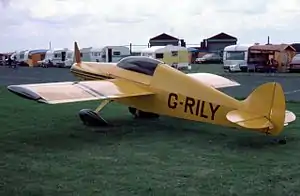 | |
| Sonerai II | |
| Role | Homebuilt aircraft |
| Manufacturer | Monett Aircraft |
| Designer | John Monnett |
| First flight | 20 July 1971 |
| Introduction | 1971 |
Later versions included a low-wing Sonerai IIL,[3] a tricycle-gear Sonerai IILT[3] and finally the stretched Sonerai IILS and IILTS.[3][4]
John Monnett came up with the name Sonerai from a combination of the words Sonic and Cosmic-Ray [5] Many Sonerais have been built and it remains a very popular design for people seeking a low-cost experimental aircraft with good speed and maneuverability. The airframe cost to build in 1974 was estimated at $2,500. The 2010 airframe cost is approximately $6,000 (US) and the total cost is approximately $15,000 (US) with the addition of hardware, instrumentation, engine and other required items. The time to build is between 800 and 1000 hours.[6]
Design and development
The Sonerai I design and construction started in 1970 with the goal of a flying aircraft to be demonstrated at the 1971 EAA airshow. The aircraft was to meet the new Formula V rules and those of the Professional Race Pilots Association (PRPA) for aircraft powered by 1600cc Volkswagen engines (it will accept VW engines from 1600 to 2800cc displacement).[1]
Inspired by the Spitfire, an elliptical tail profile was incorporated. Elliptical wingtips and a low-wing configuration were dropped, but a low-wing Sonerai II variant was released later.[7] The Sonerai I was designed to use a direct drive 1,600cc VW engine[1] and the Sonerai II was designed to use the 1700cc VW engine.
The wings were designed to fold alongside the fuselage for towing without a trailer and compact storage.[1] The Sonerai II was designed to be soloed from the rear seat. The aircraft is built around a fabric-covered steel-tube fuselage and tail,[1] with all-aluminum wings[1] and a fiberglass cowl. The plans cost $50 and $57 in 1974.[8]
Great Plains Aircraft Supply Company held the rights to the Sonerai series of aircraft until 2015. Sonerai Works LLC, of Franksville, Wisconsin, purchased the rights to Sonerai plans and parts from Great Plains in 2015. Sonerai Works LLC was formed by Fred Keip. a Sonerai IIL builder, owner, and pilot, who was Sonerai Newsletter editor and publisher 1996 –2010, and had been a technical support provider for Sonerai builders over 28 years (an EAA Technical Counselor since 1987).[3][9]
In December 2019 the design was acquired by Sonex Aircraft.[10]
The aircraft is not available as a kit, and is built using plans, although some parts are available.[11]
Operational history
The prototype Sonerai 1 was displayed at the Experimental Aircraft Association Airshow in Oshkosh, Wisconsin where Monnett eventually relocated. The aircraft was painted a bright green that became the color of all the future prototypes and company marketing. The shade was from a 1971 Dodge Charger John Monnett saw painted Sassy Grass Green.[12]
World records

Brian Dempsey built a Sonerai I that set a world record. The C-1a/0 (Landplanes: takeoff weight less than 300 kg) Speed over a straight 15/25 km course of 292.15 km/h (181.53 mph / 157.74 kts) on February 19, 1989.[13] Dempsey's record stood for 20 years.
Robin Austin of Australia built a Sonerai IIL with a 100 hp Rotax engine. The aircraft has set the following FAI records for C-1a/0 (Landplanes: takeoff weight less than 300 kg).[14]
- Aeroplane Efficiency : 29.79 km/kg 05/06/2008 Jacobs Well, QLD (Australia)[15]
- Speed over a recognized course 404.3 km/h (251.2 mph / 218.3 kts) 17 May 2008 St. George, QLD (Australia) - Brisbane, QLD (Australia)[16]
- Speed over a recognized course 440.0 km/h (273.4 mph / 237.6 kts) 28 Jul 2008 Blackall, QLD (Australia) - Rockhampton, QLD (Australia)[17]
- Aeroplane Efficiency 37.22 km/kg 08 Jun 2008 C1-b Class[18]
Variants
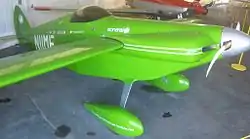
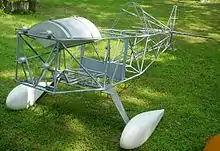
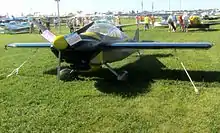
- Sonerai I
- Single-seat Formula V Racer[1][19]
- Sonerai II
- Two-seat, mid-wing, conventional gear[19][3]
- Sonerai II-L
- Two-seat, low-wing, conventional gear[19][3]
- Sonerai II-LT
- Two-seat, low-wing, tricycle gear developed in 1983.,[19] conventional gear[19][3][20]
- Sonerai II-LS
- Two-seat, low-wing, stretched fuselage, conventional gear[19][3][4]
- Sonerai II-LTS
- Two-seat, low-wing, stretched, tricycle gear[19][3][4]
Specifications (Sonerai II)
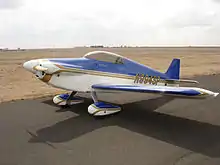
General characteristics
- Crew: 1
- Length: 18 ft 10 in (5.74 m)
- Wingspan: 18 ft 8 in (5.69 m)
- Empty weight: 520 lb (236 kg)
- Max takeoff weight: 950 lb (431 kg)
- Powerplant: 1 × Great Plains Type 1 Front Drive Volkswagen air-cooled engine air-cooled flat-four
Performance
- Maximum speed: 170 kn (200 mph, 320 km/h)
- Cruise speed: 120 kn (140 mph, 230 km/h)
- Stall speed: 39 kn (45 mph, 72 km/h)
- Range: 213 nmi (245 mi, 394 km)
- Rate of climb: 500 ft/min (2.5 m/s)
References
- "The Sonerai I," GreatPlainsAS.com / Sonerai Works, retrieved November 11, 2020
- Plane and Pilot's Homebuilt Aircraft Annual. Winter 1975. Missing or empty
|title=(help) - "SoneraiWorks LLC is Now the Supplier of Plans and Model-Specific Parts for the Sonerai Series of Sport Aircraft," press release, as reprinted December 10, 2014, Kitplanes, retrieved November 11, 2020
- "The Sonerai II Stretch," GreatPlainsAS.com / Sonerai Works, retrieved November 11, 2020
- Bob Barton (May 1991). "Bob Barton's Sonerai IIL". Sport Aviation.
- "Sport Aircraft History". Great Plains Aircraft. Retrieved 2008-10-08.
- "Race to Oshkosh". Sport Aviation: 6. March 1972.
- "Flying Twins your choice of one or two". Popular Mechanics: 108. Aug 1974.
- Sport Aviation: 15. February 2015. Missing or empty
|title=(help) - Cook, Marc (30 December 2019). "Sonerai Kit Aircraft Comes Home". AVweb. Archived from the original on 2 January 2020. Retrieved 15 December 2019.
- Bayerl, Robby; Martin Berkemeier; et al: World Directory of Leisure Aviation 2011-12, page 104. WDLA UK, Lancaster UK, 2011. ISSN 1368-485X
- Jim Cunningham. John Monnett from Sonerai to Sonex.
- "FAI world Records". Retrieved 18 Jan 2015.
- Robin Austin (October 2010). "Four World Records". Sport Aviation.
- "FAI Record ID #15065 - Aeroplane Efficiency, C-1a (Landplanes: take off weight 300 to 500 kg) " Fédération Aéronautique Internationale Record date 5 June 2008. Accessed: 4 October 2015.
- "FAI Record ID #15060 - Speed over a recognized course, C-1a (Landplanes: take off weight 300 to 500 kg)" Fédération Aéronautique Internationale Record date 17 May 2008. Accessed: 4 October 2015.
- "FAI Record ID #15100 - Speed over a recognized course, C-1a (Landplanes: take off weight 300 to 500 kg)" Fédération Aéronautique Internationale Record date 28 July 2008. Accessed: 4 October 2015.
- "FAI Record ID #15066 - Aeroplane Efficiency, C-1b (Landplanes: take off weight 500 to 1000 kg) " Fédération Aéronautique Internationale Record date 8 June 2008. Accessed: 4 October 2015.
- Purdy, Don: AeroCrafter - Homebuilt Aircraft Sourcebook, Fifth Edition, page 171. BAI Communications, 15 July 1998. ISBN 0-9636409-4-1
- Flying: 12. May 1983. Missing or empty
|title=(help)